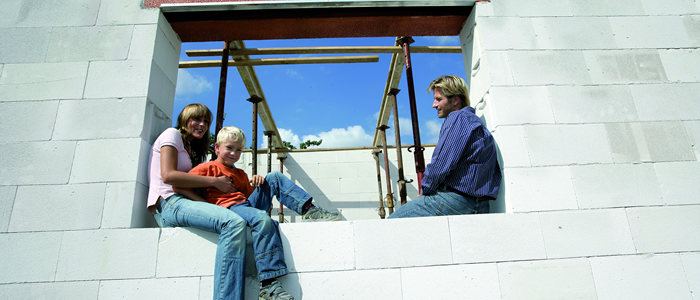Building with AAC
by Daphne Construction in Hebel | 0 comments
What is AAC is normally the first question asked? AAC (autoclaved aerated concrete) is a common building material that is now used in the US. It’s a building material that can be cost effective with many benefits. Most builders, concrete contractors, and homeowners in the US are aware of the new building material AAC yet. There are two common types of AAC wall products – blocks and panels. Panels have reinforcement molded into them and can be as large as 20 feet long. Panels are typically secured to floors and decks in a mortar bed and held in position with the same kind of braces used by precast or tilt-up concrete contractors. Blocks, on the other hand, require less engineering and time to place, and reinforcement is easy to install onsite.
Most builders, including our workers, use AAC for exterior wall construction and occasionally for load-bearing interior walls. Our workers set the first course of AAC blocks on a bed of masonry mortar. The thickness of the mortar bed allows them to set this first course level, which is critical to the construction of a wall. The remainder of the AAC block courses are bonded to one another with a polymer thin-set mortar and spread with a notched trowel to get a joint thickness of about 1/8 inch. The thin-set mortar is similar to what tile setters use and is exceptionally strong. It’s almost impossible to break blocks apart. In addition, because the joints are so thin, the R-value and thermal efficiency of the wall are hardly affected.
There are several ways to reinforce AAC walls. Typically, plans call for vertical reinforcement every 4 feet and within 4 inches on both sides of corners and alongside window and door openings. One option is to order about 60 percent of the blocks with 3-inch pre-cored holes to hold vertical reinforcement. If needed, the holes can be easily drilled on the job site instead. The onsite workers place re-bar, or threaded rod, into the holes and attach it to the footings. The holes are then filled with grout as strong as 5000 psi, depending on structural requirements. Engineered bond beams are typically located at the tops of walls to tie wall systems together and provide the proper attachment for mud-sills and roofs.
Providing for windows and doors is easier than cast-in-place wall systems – no forms or bucks are required. Workers typically construct bond beams above and below windows and at the tops of doors, adding reinforcement and filling them with grout. Vertical reinforcement on either side of an opening typically extends into these bond beams. Where the walls tie into roof members and where the above-grade floors meet walls are two additional locations on where AAC walls require special attention. Reinforced concrete bond beams are normally included at each location and the building members are attached to them.
Our workers often install rough electrical in AAC walls by routing channels into the face of the wall for placing conduit or wire. The channels are then filled afterwards with patching products. Plumbing is usually placed in the cavities of wood or steel studded interior walls.
For the final finish, AAC has an advantage over many other wall systems when utilizing plaster, stucco, or overlay cement finishes since no additional preparation work is needed. Drywall and other types can typically be attached directly to the AAC. One of the biggest benefits in constructing with AAC is that standard wood cutting tools can be used to shape AAC and little to no material is ever wasted.
Up front, AAC prices are cost competitive to wood home builders materials. However, in the end, the homeowner will obtain more savings on the AAC materials as it’s considerably more energy efficient. Another area in savings to the homeowner is less maintenance needed or required as ACC avoids the worry of termites and mold. AAC also ensures better safety as it better handles major weather conditions, such as hurricanes, tornadoes, and fires.
For a better explanation on what AAC construction can do for you, as a homeowner or builder, visit our Discover Hebel and AAC page or contact us at 225-366-2299 or visit our office. Providing focus on current home building innovations saves everyone time and money.
Tags: AAC, Hebel





